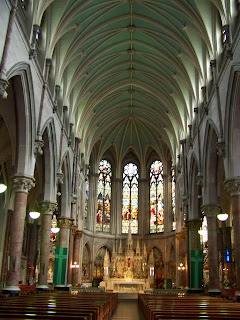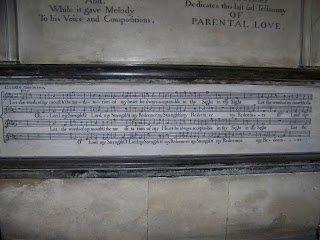The rail and ferry journey was great, and I checked into my room at Trinity U., Dublin at about 8:30PM. Through email correspondence I had learned that ringers from Southwark Cathedral were also visiting Dublin this weekend on a ringing outing, and that I was welcome to join with them ringing today. I had planned on ringing in both of the major Cathedrals (neither Roman Catholic) but they were ringing in a few more!
The first was at 9:30AM - a very beautiful Catholic church designed by E.W. Pugin, son of the famous A.W. Pugin. I found many architectural and ornamental aspects that reminded me of our own Cathedral of St. John the Baptist, also designed by an Irish architect. The steeple is the highest in the city, but the tower was not designed for bells - you can read about them HERE.
The climb up to the ringing room was wild! (See the above link to the church's website about the bells.) The first spiral staircase went only up to the choir loft. The pipe organ is spread across the back wall with two casework towers left and right. These have facade pipes, but no interior pipes. On the left side this case hides the lower part of another steel spiral stair leading up to a straight stair into the ceiling above the choir loft! (A few of the Southwark Cathedral ringers declined to go up.)
Views from the stairs:
The ringing room is narrow, with bells 1-4 in a straight line along the west wall. The sallies are green/white/yellow, the national colors of Ireland:
This ring is anti-clockwise, i.e. the lighter weight bells are to one's left rather than right. The tenor bell weighs 2550 pounds. I rang the #5 bell to a touch of Grandsire Caters (9-bell method). This being my first ever anti-clockwise ringing, I was surprised that this was one of my best on this method!
Here are some photos of the beautifully decorated interior:
Oh! And there's a connection between this church and a Diocese in India:
Next, we all walked a few blocks to Christ Church Cathedral where they have augmented their bells to a total of 16! I rang rounds and call changes on the #4 bell. The calls were to be executed similarly by each group of four bells, e.g. bells 5-8, 9-12, and 13-16 were each considered to be 1-4. The rest of the ringers were capable of more complex ringing in 16, but I just watched and listened!
Here are photos of both exterior and interior:
And the organ is by Irish builder, Kenneth Jones, whose firm also built the organ at St. Michael's in downtown Charleston.
(photo from the internet)
More on the rest of the day later.




































1 comment:
Thanks for the magnificent photographs -- they repay detailed study by all the architecture fans out here.
I spent a lot of time admiring details. Great blog.
Post a Comment